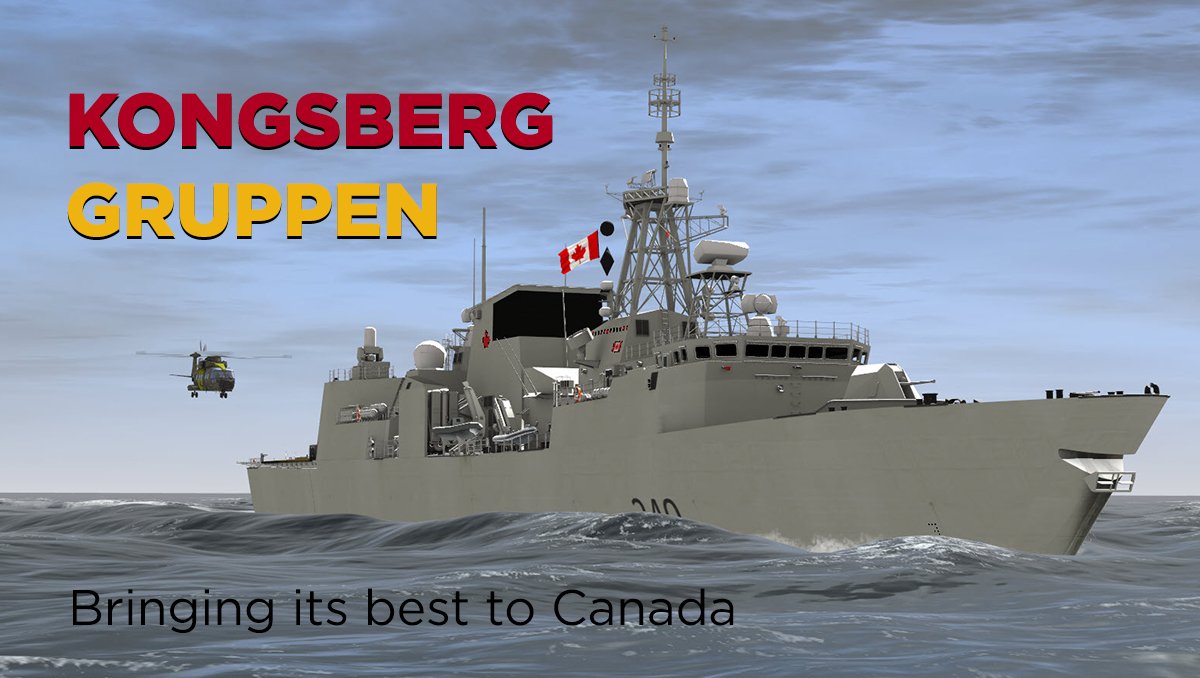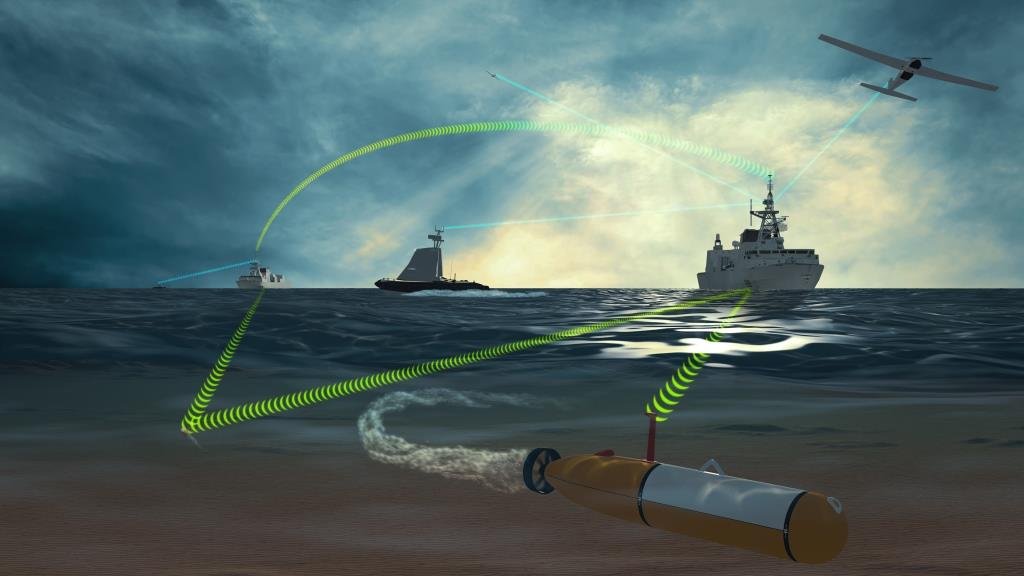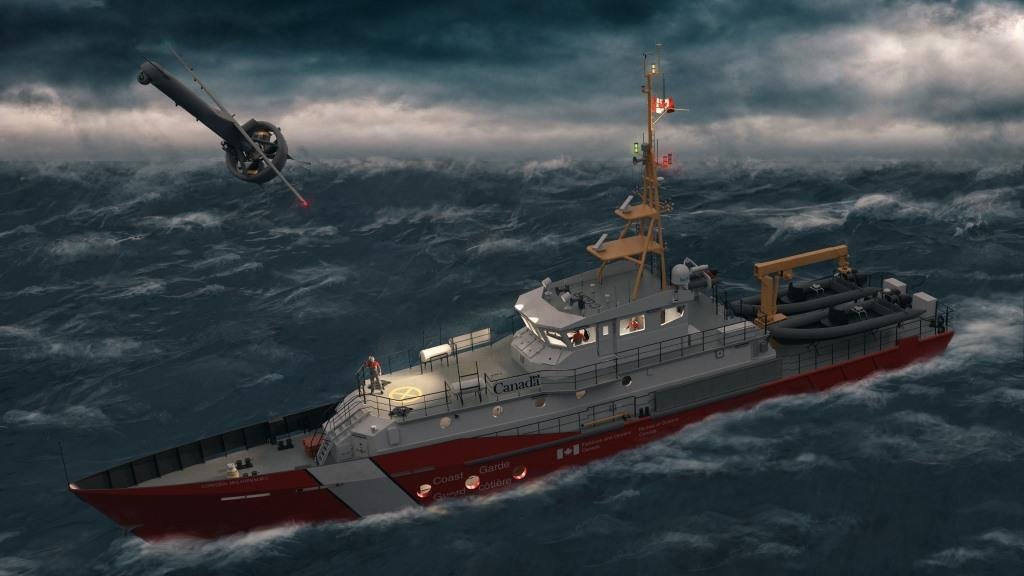TECHNOLOGY SPOTLIGHT - Kongsberg Gruppen
BY JAMES CARELESS
KONGSBERG GRUPPEN
BRINGING ITS BEST TO CANADA

For more than 200 years, Norway’s Kongsberg Gruppen (Kongsberg) has bolstered the defence of this Scandinavian country through military products and services. Today, Kongsberg is a multi-billion dollar international tech group whose divisions are helping to keep Canada, Norway, and NATO safe.
“Kongsberg has a proven track record of providing key capabilities to the Norwegian defense operating in the High North,” said Major General Odd-Harald Hagen, Defense Attaché and Defense Cooperation Attaché at the Royal Norwegian Embassy in Washington, DC. “Their
cutting-edge technologies are developed for use in harsh and unfriendly climatic conditions, like those found in Norway and Canada.”
Here are four Kongsberg divisions that are contributing to Canada’s defence today.
KONGSBERG DEFENSE & AEROSPACE ON GUARD FOR CANADA
Kongsberg Defence & Aerospace (KDA) is Norway's premier supplier of defence and aerospace-related systems and solutions, and a key supplier to the Canadian Armed Forces.
A case in point: “The Canadian Army uses the KONGSBERG PROTECTOR Remote Weapon Stations (RWS) on a range of its wheeled vehicles, most notably the Tactical Armoured Patrol Vehicle,” said Scott Hall, KDA’s Manager of Business Development. “KDA is under contract for, and is currently delivering, our latest PROTECTOR RWS RS4 for the Army’s new Armoured Combat Support Vehicles. KDA was also selected by the Royal Canadian Navy to provide their ships with our Naval Strike Missiles (NSM).”
In fact, KDA is comprised of five businesses that supply military customers with defence products and systems for command and control, surveillance, space, tactical communications, remote weapon stations and missiles systems. “These include our KONGSBERG NSM from our Missiles Division, our NASAMS (National Advanced Surface-to-Air Missile System) made by our Integrated Defence Systems division, and our portfolio of PROTECTOR remote weapon systems provided by our Land Systems division,” said Hall.
Worth noting: The NSM has been chosen by multiple NATO members for both ship-based and land-based operations. In addition to Canada, NSM users now include Norway, the United States, Germany, the United Kingdom, and Poland.
“The NASAMS air defence system was recently deployed in Ukraine, where it is actively defending key Ukrainian infrastructure against both air and missile attacks,” Hall told CDR. KDA is the market leader for Remote Weapon Stations, with over 22,000 RWS delivered to-date.
Although KDA is a small company, its Norwegian heritage stretches back some 200 years. “We are nearly as old as the country, and through two centuries of innovation and delivering results, KDA is now recognized as a global technology leader,” said Hall. “We take pride in developing advanced technology and products of strategic importance around the world. Our core values are shared throughout all of Kongsberg Gruppen, which are based on determination, innovation, collaboration, and reliability. Those four words sum our company up quite nicely.”
KONGSBERG GEOSPATIAL MODERN MAPPING EXPERTS 
Kongsberg Geospatial builds precision software that is used for mapping, geospatial visualization, and situational awareness. Based in Ottawa, the company was originally branded as Gallium Software until Kongsberg purchased it in 2005.
“Our pedigree comes out of the defence industry,” said Jordan Freed, President and Managing Director of Kongsberg Geospatial. “In the days of Gallium Software, our flagship mapping product was called InterMAPhics. It was a mapping graphics tool for military command and control systems that could identify large numbers of movements at high speed on a map in real time.”
InterMAPhics was subsequently adopted by Lockheed Martin under license to build their Aegis operator interface. To this day, they continue to license that product from Kongsberg Geospatial. It has been rebranded as TerraLens, and is being used by other major defence players as well.
“TerraLens has been our core product for the majority of our 30-plus years of existence,” Freed told CDR. “About five or six years ago, we started to move into the unmanned space with the growth of drones and other unmanned vehicles, and started looking for ways to build applications based on TerraLens.”
This includes integrating TerraLens in KDA’s National Advanced Surface-to-Air Missile System. “We took the NASAMS user interface and built our airspace management/situational awareness product called IRIS, which is being used to safely manage drone traffic in defence and for civilian missions such as deliveries of medical organs and Search and Rescue,” he said.
Kongsberg Geospatial’s accomplishments don’t end there. The company has helped to develop NATO’s Alliance Ground Surveillance (AGS) System. According to NATO’s website “NATO's Alliance Ground Surveillance (AGS) system is composed of five NATO RQ-4D ‘Phoenix’ remotely piloted aircraft and a series of associated ground command and control stations. The AGS system gives commanders a comprehensive picture of the situation on the ground, providing a state-of-the-art Intelligence, Surveillance and Reconnaissance (ISR) capability to NATO.”
“Our work consisted of developing the data retrieval storage and visualization system for the drones, which we have since evolved into a product call MIDAS,” said Freed. Short for Modular ISR Data Analysis and Storage, MIDAS is a near real-time system for processing and sharing Intelligence, Surveillance and Reconnaissance (ISR) sensor data for UAS and other Unmanned Systems (UxS). MIDAS is designed to provide a simple yet powerful interface for reviewing and comparing real-time, near real-time and historical sensor data from drones, including full-motion video.
“With MIDAS, UAS operators can analyze sensor data; view it in a temporal context; and even have access to AI tools for tasks like full-motion video analysis without having to wait for data to be transferred to headquarters for analysis,” says the Kongsberg Geospatial website. “This allows operators to develop actionable intelligence from sensor data at the forward edge, where it's needed the most.”
At Kongsberg Geospatial, they refer to MIDAS as delivering PED (Process, Exploit, and Disseminate Sensor Data) to the Edge. “It's certainly not fulfilling the entire PED function, but it's fulfilling the ‘pointy end of the stick’ by allowing that functionality to be in the hands of operators that historically would've run the mission and then lost all that data the minute that the next mission was run,” Freed told CDR.
MIDAS is a big part of Kongsberg Geospatial’s proposal for the RCN’s ISTAR UAS program. It has partnered with Voyageur Aviation and Shield.AI to form ‘Team V-BAT’ for that procurement bid. Shield.AI’s V-BAT drone is a UAS built for shipborne operations. It has logged thousands of hours of shipboard operations with the US Navy, Marine Corps and US Coast Guard. Capable of taking off and landing vertically and then flying in horizontal flight, the V-BAT can carry multiple Intelligence, Surveillance, and Reconnaissance (ISR) payloads simultaneously over land and sea.
Winning the ISTAR bid would be a major advance into the Canadian defence space for Kongsberg Geospatial. “We’re waiting for the formal RFP for ISTAR to drop this summer, after six years of this procurement process,” said Freed.
KONGSBERG DIGITAL DECADES OF SIMULATOR EXPERTISE 
Kongsberg Digital has been providing the world with cutting-edge defence simulator solutions for over 50 years.
“We have expertise in Bridge, Engine Room, Fast Craft, High Voltage, Crane, and Safety simulators,” said Owen Brine, Kongsberg Digital’s Project Manager for Operations. “Our simulators are flexible, which allows training across the full spectrum of defence maritime platforms and operations. With the latest release of our cloud-based simulations, Kongsberg Digital can provide additional training applications anytime and anywhere.”
The Royal Canadian Navy (RCN) has been relying on Kongsberg Digital simulators for over 25 years. It is using their products to teach Naval Warfare Officer Navigation and Seamanship Training skills to the RCN’s regular forces and naval reserves. “To support both domestic and expeditionary force generation activities, Kongsberg Digital provides the RCN with high-fidelity hydrodynamic models of its entire fleet and simulates all major navigation areas along Canada’s three oceans, in addition to hundreds of international harbours and waterways,” said Brine.
Looking ahead, Kongsberg Digital is eager to support training for the RCN’s Canadian Surface Combatant ships.
“Our family of products is ideally suited to meet RCN needs to prepare sailors and crew as they prepare to receive this new class of warship,” Brine told CDR. “For instance, our fully interfaced Bridge and Engine simulation will provide unsurpassed realistic crew training across the full spectrum of naval operations. In concert with other players in the Canadian defence industry, the RCN will be able to capture vast amounts of platform and human performance data through our platforms to improve the Navy’s collective knowledge and gain insight into future training needs.”
Internationally, Kongsberg Digital provides many NATO allies and other countries with ship bridge and engine room simulators. For instance, Kongsberg has delivered a full ship solution to the Royal Australian Navy with a connected Bridge and customized Engine Room simulator system. Meanwhile, to assist small craft operators in the conduct of defence operations Kongsberg Digital has provided motion-based fast-craft simulators to the Singapore Police and Coast Guard. Most recently, Kongsberg Digital was awarded the contract to support the Royal Navy with cutting-edge simulation technology, as part of Project Selborne’s modernization of Royal Navy training.
It is worth noting that Kongsberg Digital simulation products are used throughout the entire Canadian maritime sector, and not just in defence. Clients include the Canadian Maritime Training Institutes that educate all Canadian seafarers, the Canadian Coast Guard College, and
Canadian Pilotage Associations – including the Pacific Pilotage Association. It recently
purchased a large 360-degree Bridge and Tug simulator for its pilots and students in this region.
“With a focus on marine safety, Kongsberg Digital Maritime simulators are fully accredited to meet ‘Det Norske Veritas’ and ‘Standard for Training, Certification and Watchkeeping’ criteria, and are Transport Canada-approved,” said Brine. “We have worked extensively with international accreditation organizations to ensure our products surpass international standards. As a testament to the high fidelity of our product line, we are the sole Engine Room simulator provider to meet Transport Canada requirements for Propulsion Plant Simulator 1 and 2.”
KONGSBERG MARITIME DOING ITS BEST WORK UNDERWATER
Kongsberg Maritime offers a varied suite of products and solutions to ships, both above and below the waves. Its technology is being used by more than 30,000 ships worldwide.
“We offer a wide range of mil-spec and commercial products to the defence sector,” said Nick Burchill, Kongsberg Maritime’s Vice President of Sales for Canada. “In this country, we are largely known for our sensors and robotics products such as Autonomous Underwater Vehicles (AUVs) and sonar systems for mapping and detecting objects. We also provide the steering gear, propellers, stabilizers and part of the replenishment systems for the BAE Type 26 platforms on which the RCN’s Canadian Surface Combatant ships will be based.”
Working with the Canadian Armed Forces is nothing new for Kongsberg Maritime. In fact, they are a longstanding trusted supplier. A case in point: “We are engaged as the AUV (autonomous underwater vehicle) provider to the RCN’s Remote Minehunting and Disposal system (RMDS),” Burchill said. “We do the steering gear and other components on most major Canadian warships including AOPS (Arctic and Offshore Patrol Ships) and the RCN’s Halifax-class ships, and we provide underwater mapping systems and search and recovery sonars for the Government of Canada.”
That’s not all: Kongsberg Maritime Canada Limited is actively engaged in this country’s major maritime projects, including the National Shipbuilding Strategy and its Canadian Coast Guard fleet renewal program. “Internationally, Kongsberg Maritime offers our allies a broad range of equipment and services,” said Burchill. “These range from vessel design and engineering services to steering gear, propellers, sensors and sensor platforms.
When asked what makes Kongsberg Maritime stand out from the competition, Nick Burchill echoes the words of Scott Hall when he says, “we live our core values. We are Determined, Innovative, Collaborative, and Reliable. And we have more than 200 years experience in delivering quality to our customers. On that note, we just celebrated the 50th anniversary of our Port Coquitlam, BC facility – known as Kongsberg Mesotech – which directly employs 57 team members and draws from many Canadian suppliers.”
“We are located across Canada and we are growing,” Burchill concludes. “We look forward to working more with our Canadian customers, as well as industry and research partners.”
James Careless is CDR’s Ottawa Bureau Chief

